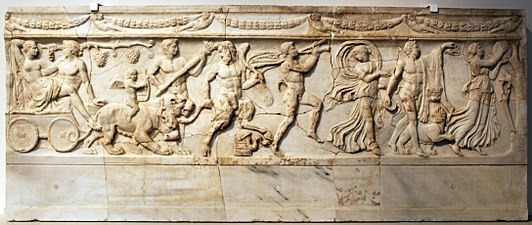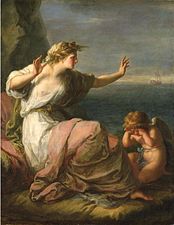Ariadne
In Greek mythology, Ariadne (in Greek Ἀριάδνη, from the Greco-Cretan form arihagne, 'the purest') was a Cretan princess, daughter of Minos and Pasiphae.
Etymology
The name of Ariadne has been attributed the meaning of "very pure", from the adjective ἁγνὸν. Some scholars, such as David West, however, consider that this meaning is an invention and have proposed another etymology in which they derive the name from the Ugaritic words ar and adn, whose meaning would come to be "light of the father or lord".
The myth
Minos and Pasiphae ruled Crete. After the death of his son Androgeo, Minos decided to attack Athens and also launched a series of curses that caused the Athenian territory to suffer drought and famine. In exchange for peace, the Athenians were to send seven young men and seven maidens each year to feed the Minotaur. One year Theseus, son of Aegeus, king of Athens, volunteered with the young men to free his people from tribute.
Ariadne fell in love with Theseus at first sight, like other female characters who helped bring about the new order (a mytheme that was characterized as "of the deserters" by Ruck and Staples), and helped him by giving him a ball of thread that she was spinning or, according to other sources, a luminous crown so that she could find her way out of the Labyrinth after killing the Minotaur. Ariadne then fled with Theseus, but according to the Odyssey' She "could not achieve it, because Artemis slew her in Dia, lying in the midst of the waves, for the accusation of Dionysus." Homer does not explain the nature of Dionysus's accusation.
In Hesiod's work and most other sources, Theseus abandoned Ariadne, leaving her asleep on Naxos, and Dionysus rediscovered her and married her. There are different traditions about the reason for this abandonment of her: he would have done it because Dionysus made him forget about her, or by order of Athena or Hermes; or out of sheer forgetfulness or contempt for her, or out of shame at coming to Athens with her, or because he loved Aegle. Another story told that the ship where they were traveling suffered a storm around Cyprus and that Ariadne, who was pregnant with her, was put ashore on the aforementioned island, but Theseus had to leave her there to help the ship. In this account, Ariadne died on the island before she could give birth, and when Theseus returned, he ordered sacrifices to be held in her honor. Another tradition pointed out that after being abandoned by Theseus, she Ariadne married a priest of Dionysus named Ónaro. In an alternate version, Theseus did not abandon her, but Ariadne was kidnapped by Dionysus and brought to the island of Lemnos.
Another tradition mentioned that Dionysus took her to the island of Donusa to escape persecution by Minos. With Dionysus, she was the mother of Oenopion, Toante, Staphylo, and Pepareto.
The crown Ariadne received as a wedding gift was ascended into the heavens as the constellation Corona Borealis.
Ariadne remained with Dionysus until Perseus later fought Dionysus at Argos and killed Ariadne by petrifying her with Medusa's head or by throwing a spear at another warrior. In other myths, Ariadne hangs herself after being abandoned by Theseus. According to Hesiod, she was immortalized by Zeus.
In Roman mythology, the comparable goddess is Libera, whom Roman poets associated with the Greco-Minoan Ariadne. Ariadne was especially worshiped on Naxos, Delos, Cyprus, and the region of Locris. She was probably also venerated in Argos, where a tradition indicated that her tomb—located in the temple of the Cretan Dionysus—was preserved there. The Contest of Homer and Hesiod also mentions a festival in honor of Ariadne at the place where Hesiod's body was found, although this mention of Ariadne is not certain.
Iconography
The first certain representations of Ariadne in art appear in the archaic period, in the second half of the VII century a. C., in which she appears linked to Theseus through the episode of the Minotaur. She is also represented as the wife of Dionysus. Since then the couple has often been considered, in iconography, as a symbol of happy marriage, as in works by the Heidelberg Painter, around 560 BC. C. In black-figure ceramics, in addition to meeting scenes between Ariadne and Dionysus, there are representations of Ariadne as a charioteer. Sometimes Ariadne also appears as part of Dionysus' uncle but in a prominent way, participating in a symposium, a scene that also appears on red-figure ceramics.
In the classical period the figure of Ariadne continues to appear often as the wife of Dionysus in festive settings or even where both embrace or kiss. In addition, scenes are represented in which Dionysus pursues Ariadne, sometimes with the presence of Eros. Another iconographic motif in which Ariadne and Dionysus appear is associating both characters with the theater, as in the Pronomo's crater or in Lycurgus's hydria of madness. There are also some images that represent the abandonment suffered by Theseus and his subsequent encounter with Dionysus, as in the so-called Berlin Hydria .
This episode of Ariadne's abandonment was later the favorite event for Ariadne performances in the Hellenistic and Roman periods. It is found in mosaics, reliefs and paintings in which, together with her uncle, Dionysus finds Ariadne who, according to the prevailing version of her, was asleep. There are also images from this period in which only the figure of Ariadne lying down appears.
Representations of Ariadne ceased to appear in the Middle Ages, which reappeared in the 15th century, where Donatello represents Ariadne and Dionysus as an ideal couple. This theme was repeated continuously from this moment and, in the Baroque, a variant was popularized that represents the wedding of Dionysus and Ariadne in the presence of Aphrodite and where Ariadne sometimes receives the crown that later, according to the myth, was transformed into a constellation. The ascent of both lovers to Olympus is also represented, as in works by Giovanni Battista Tiepolo. On the other hand, the scene of Ariadne's abandonment by Theseus and her discovery by Dionysus occurred again at the beginning of the XVI century , in works by Titian. In relation to this specific mythical event, on occasion Ariadne was depicted awake but images of Ariadne asleep predominate.
Interpretations
Some researchers believe, due to her association with thread and spinning, that she was a weaving goddess, like Arachne, and support this claim with the mytheme of the hanged nymph.
Some researchers believe that Ariadne is the epithet behind an early Cretan fertility goddess, "the first divine figure in Greek mythology to be immediately recognized on Crete", once archeology had begun. They believe that this character must be identified with the theonym documented in Mycenaean tablets da-pu-ri-to-jo po-ti-ni-ja ("Lady of the Labyrinth") and that for Homer and mythology In later Greek times, Ariadne's divine origins were diluted. In an Attic cylic by the painter Esón (ca. 425–410 B.C., M.A.N., Madrid), Theseus drags the Minotaur out of a similar labyrinth to a temple, but the goddess who helps him is Athena. For the Athenian mythographers, the mentor of the founder of Athens is Pallas Athena and Ariadne is nothing more than a trophy.
According to some there would actually be two Ariadnes:
- Dioniso's wife that Perseus killed.
- The princess who fell in love with Teseo, and who would have been born two generations later.
On the other hand, a mention by Homer in which it is said that Daedalus built a dance floor for Ariadne has been interpreted by some mythologists as an allusion to the construction of the labyrinth and it has also been suggested that it could be a offering to Ariadne not as a princess but as a protective divinity.
Later Culture
- Il lamento d'Arianna (The lament of Ariadna) is a famous madrigal composed in 1608 by Claudio Monteverdi and included in his sixth book Madrigales. Il lamento d'Arianna is, in fact, the only piece that is preserved from which was the second opera composed of the Venetian genius, AriannaAfter the renamed L'Orfeo, favola in music, first opera proper of the history of music.
- Ariadne auf Naxos (Ariadna in Naxos) is the title of a cantat composed by Franz Joseph Haydn in 1789, as well as that of an opera by Richard Strauss.
- I'm sorry about Ariadna. is a poem by Friedrich Nietzsche that forms part of his Dithirambos de Dioniso.
- Ariadna is the title of a play by A. A. Milne.
- Ariadna is the title of a theatrical text by Marina Tsvietaieva, which was premiered in Seville in 2008 with the co-production of the Andalusian Center of Theater and Atalaya Theatre from the version of Carlos Iniesta.
- Ariadna is the name of Jennifer Saint's book, published in 2021. She tells the story of the princess of Crete with a feminist perspective.
Contenido relacionado
Hero
Ascanius
Satan








